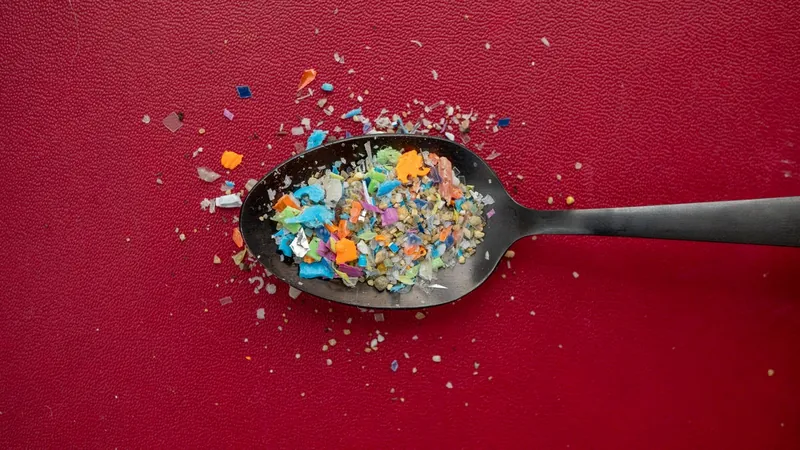
Ditch the Plastic: 7 Kitchen Items Where Microplastics are Lurking!
2025-09-05
Author: Jessica Wong
Microplastics are not just an environmental issue—they're infiltrating our lives in alarming ways! From the water we drink to the meals we savor, these tiny plastic particles are becoming nearly impossible to avoid. And while they may be invisible, their effects on our health are coming under serious scrutiny.
A groundbreaking study published in February 2025 reveals that microplastics can accumulate in human tissues, raising concerns about long-term health implications like organ damage and even neurological disorders such as dementia. Understanding the origins of these particles is crucial, especially considering that our kitchens could be the front line of exposure.
The Hidden Dangers in Your Kitchen
Surprisingly, the kitchen is one of the prime spots where microplastics are found. From how we store food to the cookware we use, you may be unwittingly inviting these pollutants into your home. But fear not! There are straightforward steps you can take to minimize your exposure.
Are Microplastics Really Harmful?
Yes, and the evidence is growing. An estimated 22 million microparticles are inhaled by people annually, making them a significant health concern. Studies have linked these particles to severe health issues, including heart attacks, strokes, tissue inflammation, and even cancer in animals. As research unfolds, it's becoming clear that what you use in your kitchen can directly impact your well-being.
7 Kitchen Items to Watch Out For!
Think your kitchen is safe? Think again. Here are seven common items that might be harboring microplastics:
1. Nonstick Cookware
Research indicates that nonstick pans—especially those coated with Teflon—can leach microplastics into your meals, exposing you to potentially harmful pollutants. Just a single crack could lead to a staggering influx of microplastic particles.
2. Plastic Food Containers
With the rise of food delivery services, plastic containers have become ubiquitous. Unfortunately, studies show that most reusable plastic food containers can leach microplastics, especially when heated or washed.
3. Plastic Utensils
Using plastic utensils? Expect microplastics to enter your meal, especially when they come in contact with hot food. It’s a seemingly small step that can have big implications!
4. Tea Bags
Think a warm cup of tea is safe? Think again! Researchers found that many tea bags, made from polypropylene, release billions of microplastics into your brew, especially in hot water.
5. Certain Spices
Your favorite spices might not be as harmless as they seem. Many spice containers—especially those made from plastic—have been found to contain microplastics, leading to food contamination. What a spicy scandal!
6. Plastic Straws
Plastic straws are now notorious for contributing to microplastic pollution. Studies show they can release harmful particles that are easily inhaled. With millions of tons of plastic in our waterways, the risk is significant.
7. Canned Food Linings
Once notorious for containing BPA, canned food linings now often contain other types of plastic. Recent studies warn that these can also introduce microplastics into your diet.
Your Guide to a Healthier Kitchen!
Ready to make some changes? Here are some eco-friendly swaps that can help cut down your microplastic exposure:
- Wooden or Stainless Steel Utensils
Upgrade your spatulas and utensils to wooden or stainless steel varieties. These not only reduce plastic exposure but can also add a rustic charm to your kitchen.
- Glass or Stainless Steel Food Containers
Say goodbye to plastic containers. Investing in glass or stainless steel can dramatically cut down on your microplastic intake.
- Loose Tea Leaves
Opt for loose tea leaves instead of bags—the health benefits are worth it! Use a stainless steel infuser for a secure, plastic-free brew.
- Spices in Glass Containers
Switching to bulk spice bins or glass containers can help keep microplastics from sneaking into your meals.
- Reusable Metal or Bamboo Straws
Plastic straws are out! Make the switch to metal or bamboo straws that are as stylish as they are sustainable.
- Focus on Fresh or Frozen Produce
Dodge the risks associated with canned goods by opting for fresh or frozen produce that skips the plastic.
- Switch to Cast Iron or Stainless Steel Cookware
Elevate your cooking experience with cast iron or stainless steel pans—non-toxic and stylish!
The Bottom Line
Microplastics are stealthy intruders in our kitchens, lurking in everyday items and finding their way into our food. While ongoing research seeks to uncover the full extent of their impact, one thing is clear: it’s time to take a hard look at what’s in your kitchen and make informed choices for your health.



 Brasil (PT)
Brasil (PT)
 Canada (EN)
Canada (EN)
 Chile (ES)
Chile (ES)
 Česko (CS)
Česko (CS)
 대한민국 (KO)
대한민국 (KO)
 España (ES)
España (ES)
 France (FR)
France (FR)
 Hong Kong (EN)
Hong Kong (EN)
 Italia (IT)
Italia (IT)
 日本 (JA)
日本 (JA)
 Magyarország (HU)
Magyarország (HU)
 Norge (NO)
Norge (NO)
 Polska (PL)
Polska (PL)
 Schweiz (DE)
Schweiz (DE)
 Singapore (EN)
Singapore (EN)
 Sverige (SV)
Sverige (SV)
 Suomi (FI)
Suomi (FI)
 Türkiye (TR)
Türkiye (TR)
 الإمارات العربية المتحدة (AR)
الإمارات العربية المتحدة (AR)